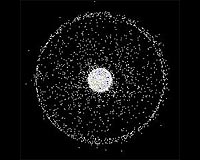 |
Bethesda MA (SPX) Oct 06, 2009 It is time for another Launchspace worldwide survey! A recent survey asked for ideas on ways to remove space debris. The response was impressive and the ideas were very useful in formulating ground and space flight concepts that might be implemented in the future when the international space community finally comes to grips with the space debris threat to operating spacecraft and to general access to space. In fact, Launchspace has helped to raise awareness of this threat and continues to contribute to the overall body of knowledge regarding space debris remediation. The results of these surveys have been, and will continue to be, passed onto researchers who are addressing many complex challenges. Last week, the Launchspace editorial addressed the fact that space-faring nations have spewed trash from 200 km to beyond 36,000 km, identifying the space below about 1,600 km as the most severely abused region. Of the more than 20,500 pieces of tracked debris, a majority are to be found in this near-Earth region. Of these, there are several thousand large objects that will eventually have to be removed from regions in which active satellites operate. One approach to removing these expired satellites and large remnants of space vehicles is to launch "orbiting trash removal satellites" into orbits near these objects. These trash removal vehicles are assumed to be highly maneuverable and able to rendezvous with each large debris object of interest. However, in order to physically remove an object, these vehicles may have to grab the object and control its movement. Once this is accomplished the removal process can begin, for example, by attaching a small removal rocket to the trash object or by storing the object in a collection container. Technically speaking, all of these steps, except one, seem to be within the current state of knowledge. The one step of concern here is the one that requires grabbing the object. Many, if not most, of the large debris objects are likely to possess some level of residual angular momentum. In layman's terms this means large debris objects are likely to be spinning or tumbling. If this is the case, then the grabbing process can be quite complicated. These objects may be large and massive, making physical contact very dangerous for a removal vehicle. Thus, any angular momentum may have to be eliminated before removal can begin. Unlike active satellites, these objects cannot be commanded to stop rotating. This is where you can come to the rescue! Launchspace wants to know how to remove any residual angular momentum from a large orbiting debris object before a satellite can capture it for removal purposes. Your ideas may help to resolve this key challenge in the space debris removal architecture. All of your submissions will be passed onto those who are actively pursuing debris removal solutions. Please help all space-faring nations to achieve success over the space debris threat. Send your residual angular momentum elimination ideas to Launchspace's DEBRIS GRAPPLING SITE Clearly, everyone in the space community should be interested in getting up to speed on space debris issues and possible solutions. This is where Launchspace can help. Register for the "must take" one-day intense seminar: Space Debris and the Future of Space Flight, November 5th in Bethesda, MD. Share This Article With Planet Earth
Related Links Launchspace Space Technology News - Applications and Research
 Space Debris Gets Some Respect
Space Debris Gets Some RespectBethesda MD (SPX) Sep 28, 2009 For the last few decades the international space community has freely used near-Earth space for many important applications without regard for the impact of artificial satellites on the space environment. Although space-faring nations have spewed trash from 200 km to beyond 36,000 km, the space below about 1,600 km has been severely abused. Recent events have finally persuaded the U.S. ... read more |
|
| The content herein, unless otherwise known to be public domain, are Copyright 1995-2009 - SpaceDaily. AFP and UPI Wire Stories are copyright Agence France-Presse and United Press International. ESA Portal Reports are copyright European Space Agency. All NASA sourced material is public domain. Additional copyrights may apply in whole or part to other bona fide parties. Advertising does not imply endorsement,agreement or approval of any opinions, statements or information provided by SpaceDaily on any Web page published or hosted by SpaceDaily. Privacy Statement |